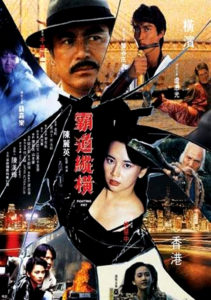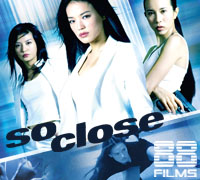AKA: Lady Cop in Fury
Director: Sonny Chiba
Co-director: Casey Chan
Cast: Sibelle Hu, Sonny Chiba, Chin Kar Lok, Song Lei, Ken Lo, Shogo Shiotani, Masashi Ishibashi, Masaru Matsuda, Gam Biu, James Ha, Lee Fat-Yuen
Running Time: 91 min.
By Paul Bramhall
Let’s face it, 1992 was a great year for Asian action cinema. Jet Li and Donnie Yen faced off in Once Upon a Time in China II, John Woo unleashed the heroic bloodshed masterpiece Hard Boiled, and Jackie Chan and Michelle Yeoh teamed up for Police Story III: Super Cop, to name just a few. In the same year, the booming V-Cinema trend in Japan would collide with Hong Kong’s Girls with Guns genre, the result of which would become Fighting Fist. Japan’s V-Cinema was at its most popular during the early 90’s, a DTV genre mainly aimed at males, which mostly focused on quickly produced action and gangster flicks. The Girls with Guns genre on the other hand, did exactly what it says on the tin – deliver movies with ass-kicking females, usually encompassing plenty of machine gun fire, pyrotechnics, and a healthy dose of fight action.
Fighting Fist is one of the few Japan/Hong Kong co-productions which came out of this era, and notably marked the sophomore directorial feature from karate legend Sonny Chiba. As a director, Chiba had gone all in on his debut, a movie called Yellow Fangs made 2 years prior. Telling the true story of a murderous bear that terrorized a mountain village in 1915, Chiba cast his protégé Hiroyuki Sanada as the lead tasked with hunting the bear, and lavished a sizable amount of his own savings to produce it. Sadly, Yellow Fangs tanked at the box office and almost made Chiba bankrupt, which resulted in him spending most of the 90’s within the V-Cinema genre, and occasionally dabbling in American action B-movies.
For Fighting Fist he’s joined by co-director Casey Chan on the Hong Kong side. Their collaboration would mark the first time for Chan to direct, having previously served as assistant director on The Twin Bracelets from the year prior. It’s safe to assume that it was likely Chan that handled the relatively small segments set in Hong Kong, and Chiba directed the bulk which is set in Japan. While Chan stays completely behind the camera, Chiba can’t resist the temptation to also take a small role in front of it. With a screentime clocking in less than 2 minutes, the Street Fighter plays a superintendent who sends an agent to Hong Kong in order to kill a gangsters brothers and son, believing that it will lure the gangster out (rather extreme I know). His scenes bookend the movie, however most distributors tend to use Chiba’s image when promoting Fighting Fist.
The agent he sends to Hong Kong is played by Shogo Shiotani. A dead ringer for a more youthful Hiroyuki Sanada, Shiotani was a member of the Japan Action Club (that Chiba had to sell off post his Yellow Fangs failure), and clearly has the moves. Shiotani would also appear in Jingle Ma’s Japan set Tokyo Raiders in 2000, however just a couple of years later he tragically committed suicide at just 35, having suffered from depression over the failure of a tokusatsu series he featured in. Once he arrives in Hong Kong, his pursuit of the gangster’s family sees him come on the radar of a pair of HK cops after the same guy, of whom are played by Sibelle Hu and Chin Kar Lok.
This is basically were Fighting Fist’s coherency goes completely out of the window, as the script throws together some of the most unconvincing character connections ever witnessed. It turns out Shiotani and Kar Lok both used to go to karate school together back in the day, and that Kar Lok’s sister (played by Song Lei from The Blade) receives flowers from Shiotani every year on her birthday (because they’re in love!). However after both Hu and Kar Lok witness him massacring the gangsters family members (in a boxed off candle lit area of a warehouse of all places), everyone hightails it across to Japan to track him down. This includes, significantly, a Chinese broadsword wielding Ken Lo (complete with hidden blades in his shoes), playing an assassin whose sole purpose is to kill Shiotani as revenge.
Interestingly there are 2 cuts of Fighting Fist, the Japanese version, which is the one being reviewed here (and which notably has everyone dubbed into Japanese), and the Hong Kong version.* The differences boil down to the Hong Kong version having a more extended fight between Kar Lok and Ken Lo, and the Japanese version containing more gore. The gore certainly stands out in Fighting Fist, sometimes making it feel like the Category III version of a contemporary HK actioner. It’s not so much a spoiler as it is a warning to say that for fans of Kar Lok, this one isn’t worth clocking in for. Not too far into Fighting Fist he has his ear graphically sliced off by Lo’s bladed boots, before the rest of his face is slashed to pieces. He eventually turns up at the police station completely dismembered, his severed head and limbs spread out over a table top.
It’s an excessively brutal end to a character, and is more reflective of the Japanese influence than anything HK was cranking out at the time. Needless to say, Kar Lok is given plenty more to do in the likes of Operation Scorpio and Martial Arts Master Wong Fei Hung, both of which came out during the same year. His early exit understandably gets Sibelle Hu riled up, and she soon finds herself Japan bound in a black PVC number, pre-dating Trinity by a whole 7 years. I couldn’t decide if I found it distasteful or not, but Fighting Fist incorporates a scene when Hu’s character reveals how she was once burnt, at which point she takes off her gloves to reveal the very real scars she suffered on the set of 1989’s Devil Hunters. In the movies finale she suffered the brunt of an explosion which went off too early, encasing her, Moon Lee, and Ray Lui in an unforgiving fireball.
Despite the fact that Fighting Fist throws the likes of Sonny Chiba, Chin Kar Lok, Sibelle Hu, Ken Lo, and Shogo Shiotani onscreen together, there’s a disappointing lack of action. Chiba and Hu in particular get zero to do on the action front, and Hu could be argued to at least be the co-lead (she’s also the character who the HK title references). Action director Ho Wing-Cheung only choreographed 5 movies, the last of which was Fighting Fist, and it’s fairly apparent to see why. Shiotani’s initial raid on the warehouse is a great example of how camera angles can work against selling a kick or a punch, and he uses the annoying step-printing technique that staggers the frame rate. The two main fights both take place between Shiotani and Lo, the first at the hour mark which is more of a chase in and around a warehouse, and a finale which is so short it’s almost funny.
The final showdown between the pair is particularly painful, as not only is it remarkably short, it’s also step-printed to the point that it resembles little more than a series of incomprehensible stills. Still, Lo’s demise is one that manages to raise a smile. Prior to the abrupt end, Shiotani briefly provides some excitement when he turns into a machine gun totting, karate-gi wearing one man army to take on a warehouse full of lackeys. However even typing it, I feel it somehow still manages to sound more exciting on paper than it actually plays out onscreen. Even with the introduction of an old-school style karate master, who teaches Shiotani the “arrow thrust” (a technique that will cause the recipients internal organs to explode 3 days later), proceedings rarely feel anything other than a slog.
Despite Chiba being an electrifying presence in front of the camera, based on Fighting Fist, it’s unfortunate to say that same level of energy wasn’t able to be transferred behind it. Featuring a wasted cast, a plodding pace, lacklustre action, and a level of coherency usually reserved for a Godfrey Ho cut ‘n’ paste flick, it’s a relief to say almost all involved would go onto work on far superior productions. At one point, the old karate master mentions that one technique of delivering the fatal blow, is to thrust your fingers into the opponent’s bowels. Despite such a description making me wince, I feel inclined to say that such an attack maybe less painful to endure than having to sit through Fighting Fist a second time.
Paul Bramhall’s Rating: 3/10
* The version viewed for this review is likely the one most are familiar with – the 2008 Rarescope release that was paired as a double feature with Soul of Chiba. As with many Rarescope releases, it states on the sleeve that “these films have been lost for many years and these recently discovered prints are the only known surviving elements available.” This is not true for Fighting Fist, and for those curious to check out the Hong Kong version, it’s relatively easy to track down on DVD under the title of Ba Dao Sha Xing, which was released in Cantonese with English subtitles by Hong Kong distributor Wide Sight in 2003.





Decent review for what sounds like a below average actioner.
With the cast of talent they had, it could have turned out to be a minor gem.
“With the cast of talent they had, it could have turned out to be a minor gem.”
That’s exactly what I was hoping for when it went in the DVD player!
Pingback: Ninjas & Fighting Fists: Sonny Chiba und Jackie Chan zusammen in einem Film? – Thorsten Boose
Pingback: Ninjas & Fighting Fists: Sonny Chiba and Jackie Chan together in one film? – Thorsten Boose